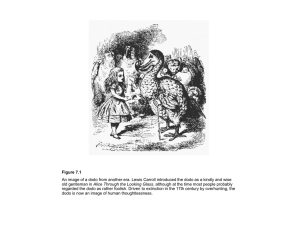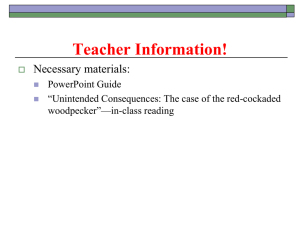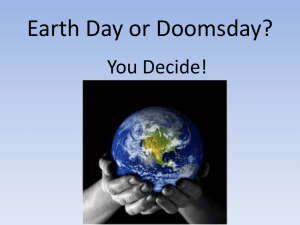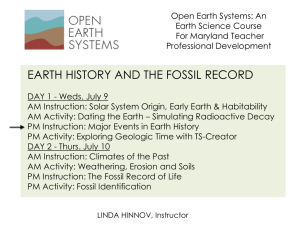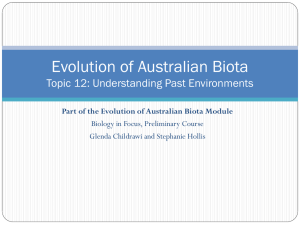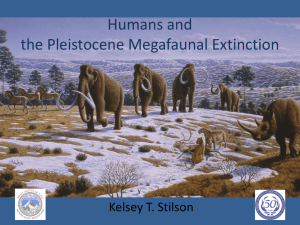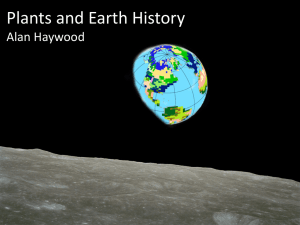Lecture Slides (powerpoint)
advertisement
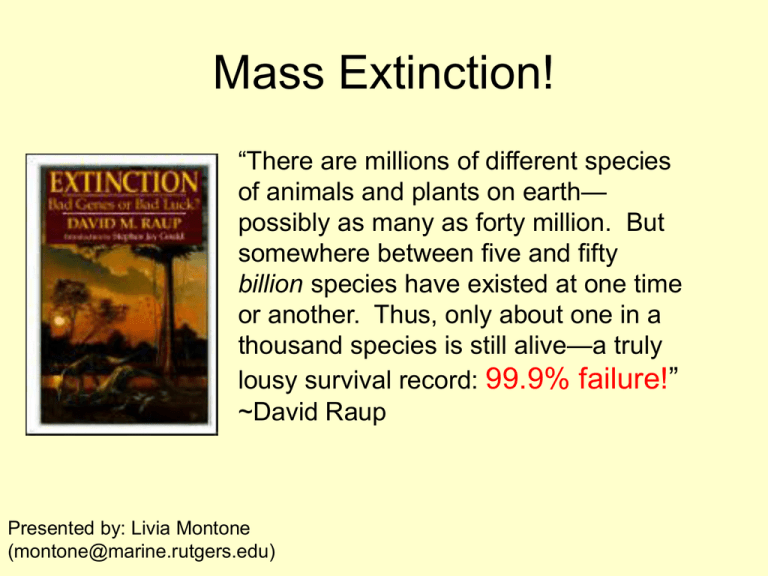
Mass Extinction! “There are millions of different species of animals and plants on earth— possibly as many as forty million. But somewhere between five and fifty billion species have existed at one time or another. Thus, only about one in a thousand species is still alive—a truly lousy survival record: 99.9% failure!” ~David Raup Presented by: Livia Montone (montone@marine.rutgers.edu) How do you define “Mass Extinction”? • Any substantial increase in the amount of extinction (ie. lineage termination) suffered by more than one geographically widespread higher taxon during a relatively short interval of geologic time, resulting in at least temporary decline of standing diversity. (from Sepkoski, 1986) How do you define “Mass Extinction”? • Any substantial increase in the amount of extinction (ie. lineage termination) suffered by more than one geographically widespread higher taxon during a relatively short interval of geologic time, resulting in at least temporary decline of standing diversity. (from Sepkoski, 1986) • An extinction of a significant portion of the world’s biota in a geologically insignificant period of time. (from Hallam and Wignall, 2000) Outline • • • • • • • Geologic Time Scale Background and mass extinctions Phases of extinction Biological causes of extinction Physical causes of extinction Geochemical Toolbox The Big Five A side note about time units vs. rock units… Time Units (ie. periods of time) • Eon • Era • Period • Epoch • Age • Rock Units (ie. sequence of rocks) • Eonothem • Erathem • System • Series • Stage Phases of Mass Extinction Biological Causes of Extinction • Minimum Viable Population and the Problems of small populations – Demographic Stochastity – Genetic Deterioration – Social Dysfunction – Extrinsic Forces GAMBLER’S RUIN! GAMBLER’S RUIN Results $10 Trial # 1 2 3 # of flips 158 14 # pos. 74 2 # neg. 84 12 192 91 101 4 5 $5 24 432 7 211 12 221 1 2 147 23 71 9 76 14 3 15 5 10 4 5 241 45 118 20 123 25 GAMBLER’S RUIN Results $10 Trial 2 $10 Trial 4 $10 Trial 5 GAMBLER’S RUIN Results $5 Trial 2 $5 Trial 3 $5 Trial 4 Survivorship Curve Proposed Physical Causes of Extinction Mass Extinctions Background extinction • Global climate change • Regional climate change • Global sea level change • Regional sea level change • Change is salinity of ocean • Anoxia • Volcanism • Extraterrestrial Impact Geochemical Toolbox • • • • Carbon isotopes Oxygen isotopes Strontium isotopes Iridium and platinum group elements Carbon isotopes • Typically reported as 𝜹13C where: 𝜹13C= • • • • • Marine biomass 𝜹13C= -25 ‰ Oceanic carbonates 𝜹13C= -0.5 to 1‰ Increase organic matter burial, 𝜹13Ccarb goes up Decrease organic matter burial, 𝜹13Ccarb goes down Ocean anoxic event= + change in 𝜹13Ccarb Oxygen isotopes • Typically reported as 𝜹18O where: 𝜹18O = • Positive 𝜹18Ocarb values indicate colder climate • Negative 𝜹18Ocarb values indicate warmer climate Strontium isotopes • Ratio of 87Sr to 86Sr is the result of: – Continental weathering processes – Interaction of seawater with basalt at midocean ridges • Marine carbonates correspond to seawater values Iridium and Platinum Group Elements • Increased Iridium (several ppb) as an indicator of bolide impact • Increased Ir with appropriate ratios to Platinum, Gold, and Asmium The Big Five • • • • • • Paleogeography Pre-extinction Taxa Big Losers Geologic and Fossil Record Possible Causes Geochemical Reconstructions Ordovician Mass Extinction Ordovician Mass Extinction Ordovician Invertebrate Fossils Ordovician Mass Extinction Ordovician Mass Extinction What went extinct in the Ordovician? • 57% of genera; >25% of families • Graptolites, conodonts, nautiloids, plankton, brachiopods, trilobites, ostracods, bryozoans, echinoderms, bivalves, rugose and tabulate corals, stromatoporoids… Ordovician Mass Extinction Ordovician Mass Extinction O-S GSSP Location- Dob’s Linn, Scotland • Other well-studied locations on Anticosti Island, Quebec Ordovician Mass Extinction Causes of Ordovician Mass Extinction • Glacial episode beginning in Mid-O • Sea level regression • Global cooling Ordovician Mass Extinction Stable Isotope Data Ordovician Mass Extinction The End-Devonian Mass Extinction Devonian Mass Extinction Devonian Mass Extinction Devonian Mass Extinction Selectivity of End-Devonian Mass Extinction • Kellwasser (Frasnian-Famennian) – Preferential loss of warm-water taxa – Loss of shallow-water taxa – Loses among some pelagic groups • Hangenberg (Devonian-Carboniferous) – Most severe extinction in water column – Less in benthos Devonian Mass Extinction Geochemical Signals • Carbon-isotopes – Ambiguous records • Oxygen-isotopes – Equally as confusing • Ir and trace metals – Enriched in Ni and V Devonian Mass Extinction Causes of End-Devonian Mass Extinction • • • • • Bolide impact Anoxia Cooling? Warming? Brackish oceans Devonian Mass Extinction Paleozoic “nemesis” The End-Permian Mass Extinction Permian Mass Extinction Geochemical Signals Causes of End-Permian Mass Extinction • • • • • • • • Cosmic Radiation Brackish Oceans Regression Bolide Impact Cooling? Warming? Hypercania Volcanic Winter Global Marine Anoxia End-Triassic Mass Extinction • Not well-studied • In marine realm- 48% extinction of invertebrate genera – – – – Cephalopods Bivalves Gastropods Brachiopods • Continental realm – Plants less affected than marine – Tetrapod turnover Geochemical Signals Causes of End-Permian Mass Extinction • • • • • Climate Change Volcanism ? Bolide Impact Sea level Change Anoxia Cretaceous-Paleogene Mass Extinction What went extinct? • • • • • Planktonic foraminifera Benthic foraminifera Calcareous Nanoplankton Organic-walled Nanoplankton Rudist bivalves, ammonites, and belemnites • Mosasaurs, ichthosaurs, and plesiosaurs • Plants Geochemical Signals Causes of K-P Mass Extinction • • • • Bolide Impact Volcanism Climate Change Marine Regression • Anoxia Summary of Possible Causes of the Mass Extinctions Mass Extinction/ Cause Sea Level Rise/Fall Climate Change EndOrdovician X (Fall) X (Cool) EndDevonian Global Ocean Anoxia Brackish Ocean Bolide Impact X (cool or warm?) X X ? X X ? X ? X? X X End-Permian X (Fall) X (cool) End-Triassic X (Fall) X (cool or warm?) EndCretaceous X (Fall) X Volcanism References (in order of importance) • Hallam, A. and P.B. Wignall (2000), Mass extinctions and their aftermath. Oxford University Press. (Chapters 1,3,4,6, and 9). • Raup, D. M. (1991), Extinction: bad genes or bad luck? W.W. Norton and Company, New York. • Stanley, S.M. (2005), Earth System History. W.H. Freeman and Company, New York. • Prothero, D.R. (2004)., Bringing Fossils to Life. McGraw Hill, New York.

